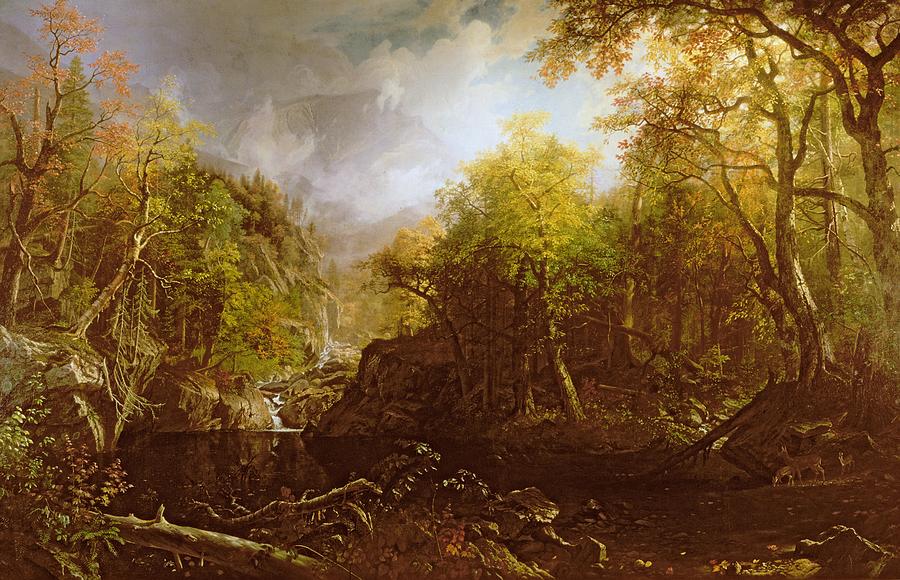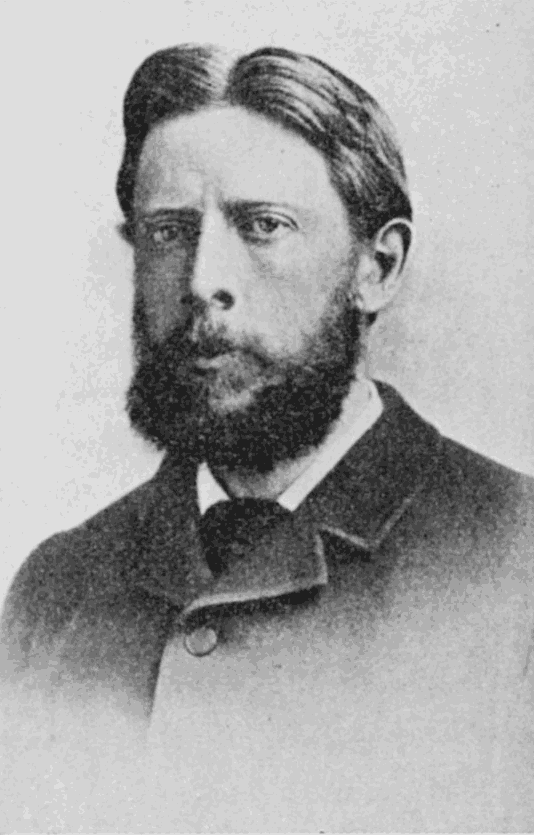
A half-hour’s climb ends at the well-worn path that follows the steep descent to the edge of Emerald Pool, made famous by its portrait by Bierstadt… At first glance at the liquid emerald below, one’s inclination is to sit down upon the rude plank seat upheld between two huge spruces growing just above the Pool, so restful and so full of repose is this charming nook. It is a place above all others in which to dream and drowse. Strange fancies flit through the brain, and the world is forgotten. I am sitting at the feet of Nature, spellbound by the magic of her subtle influences. Above is the dark silhouette of the treetops against the sky, and below is a circular sheet of water, less than a hundred feet in diameter, unsurpassed in its natural beauty by any woodland pool I have ever seen, and so translucent as to reflect the minutest object above it. It is an emerald cup brimful of liquid amber. At its head, massive buttresses of granite stretch almost across the stream, to stay the torrent of the Peabody but a moment, that with tumultuous roar pushes through the narrow flume of these rocks out into the basin of deep, calm water, leaving a track white as the snow of winter. A few feet below the commotion of the cascade, the boiling, seething current is soon lost in faint and ever-widening ripples, tinged with every shade of green from dark to light, — to almost the paleness of sherry as they reach out toward the shallows at its lower edge, where they again escape in wild, broken leaps over the mountain roadway, paved with immense boulders, into the valley. An old gnarled wide-limbed canoe birch, dirty-white, spotted with blotches of sienna and umber, leans far out over the Pool, every limb and tiny twig of which is reproduced in reverse upon or within its polished surface, while around its ragged margin the tall shapely spruces keep stately watch over this jewel of the mountain, most beautiful when the sun pours down its strong vertical light, when the waters become transparent like crystal, and that are like a huge palette strown with rare colors of sky and wood.
Herbert Milton Sylvester (1849-1923) was born in Lowell, Massachusetts, where his father held a management position of some kind in a cotton mill. When Sylvester was 10, his father related to a farm in Maine for his health. Sylvester spent the rest of his childhood there and at Bridgton Academy, a boarding school in rural Maine. After college (location unknown), he went into legal practice, serving in Portland for 13 years before relocating to Boston. While living there, he wrote Prose Pastorals (1887) and Homestead Highways (1888). True to its title, Prose Pastorals is a series of poetic vignettes, mostly reminiscences of Sylvester’s rural childhood in Maine. While not strictly nature writing (farm life figures prominently in some passages), the presence of Nature is woven throughout and is never far from the farmhouse door. “All out-of-door life is filled with poetry and charm,” he announces at one point early in the book. While he finds abundant nature in the farm fields, “It is in the woods,” he observes, “that I find the most perfect repose in nature.”
As a writer, he is perhaps a shade or two shy of profound, and some of his word images, in the style of the times, can be a bit flowery. His poetry, which infuses the book, is solid if some of the rhymes are a tad forced. It is easy to take him as a wealthy city dweller longing for the peace and quiet of his long-lost country life, and that sentiment is present here. Another theme running through the work is his spirituality, heavily influenced by Emerson’s concept of the Over-soul, the transcendent unity of nature of which we are all part. “The lover of Nature,” Sylvester declares,
must, of a truth, be a worshipper at God’s altars. Touch a single key of the piano, and the harp which stands beside will respond with perfect sympathy, but only that string of the harp which accords with that note of the piano will answer with its vibration. Men who are in sympathy with the great Tone constantly sounding throughout Nature will find their hearts unconsciously thrilled with a willing unison of purpose and desire, unconsciously answering its subtle harmonies, unconsciously obedient to the Infinite Hand which has so wonderfully laid the foundations of the grand cathedrals of the woods and mountains. The woods are filled with hosts of unseen worshippers, the mountains with countless altars whose smokes of incense are the white morning mists which lie so lightly along the tree-tops, hiding the battlements of gray, turretted stone and filling the skies with fleecy clouds. The leaping waters that jar the firmly-set rocks the feet of the ever-rising domes, with their tummult and deep reverberations, make the heavy diapson to which all other sounds are attuned. Nature’s grand melodies are ever pitched upon the same key-note. Nature knows no discord. From ocean depth and roar of breaking surf to the light treble of the shallows of the mountain brooklet the harmony is sustained and its rendering is faultless. God sounds the key-note in many a subtle touch of color, tone, and form, animate and inanimate, and wherever he finds a responsive heart there he finds a willing worshipper.
What rescues Sylvester, in my eyes, at least, is that there is another thread running through many of these pastoral pieces. He does not merely celebrate grand vistas and dramatic weather. He also bends down to the ground to explore the myriad invertebrates lurking in the forest leaf litter. He describes ant behaviors from close observations, and frequently mentions (and quotes) John Burroughs. Even Charles Darwin is mentioned a couple of times. He may find “poetry and charm” in nature, but what he notices also piques his curiosity and wonder:
Bird-life and insect-life are full of interest and fascination, and they tell charming stories of intellect and intelligence; and their movements are full of constant surprises, even to those who know them best. The big-bodied humblebee of the fields and meadows, his coat slashed with gold and black velvet, with pollen-covered wings, probing the pink-hewed tubes of the field-clover for their nectar, while the wind sways both bee and clover blossom to and fro like a child in a swing; the ant-carpenter sawing away diligently at a twig or leaf, making lumber for the building and finishing of his house; the gray field-spider setting his filmy trap for a dinner or a breakfast, or else dragging his prey into his funnel-shaped den to sup upon at his leisure, are all abundant in attractions, and are but two or three of the hosts of magicians who make the study of Nature so charming.
Humbled by the complexity of Nature, Sylvester embraces its study as a lifelong endeavor: “How much there is to see in these tramping-grounds of Nature, and how much there is to learn! The ground is written over in all directions with intelligible signs for men’s deciphering.” The passage quoted here, unfortunately, goes on to identify some of those who might seek to decipher these signs: the bee-hunter, the sportsman, the fox-hunter. Indeed, Sylvester admits to a bit of hunting and fishing; after extolling the magnificence of Emerald Pool, he casts a line into the waters and immediately catches a trout. He also shares his approval of crow-hunting, confessing that he finds no redeeming qualities in crows. But while Sylvester may have been too conventional in his leanings to bemoan disappearing birds or logged forests in his writings, he also appears to have avoided the naturalist’s worst vices of the day — shooting birds as specimens and collecting their eggs and nests. I would like to think that he may have felt some faint conservationist leanings, even if they never seem to arise in this book.
In this closing paragraph, I will share a few reflections on my reading experience. This is the third book I have read in a row (not counting the booklet by Minot) that had uncut pages in it, despite its age. In the other two volumes, I did not come across an uncut page until quite a distance into the work. In this case, though, I made it only 13 pages before the first one. According to a hastily scrawled note inside the front cover, the book was a gift from HRP to LS in July of 1887. Apparently, HRP was not a good judge of the reading material LS preferred. That said, reading the book was a tactile delight. The pages are gilt at the top, deckled at the edge, and constituted of high-quality, laid paper. The volume is covered in plain, dark blue cloth that has a pleasant softness in the hand. My copy is in remarkable condition; I was honored to be its first reader, only 135 years after it was originally published.
